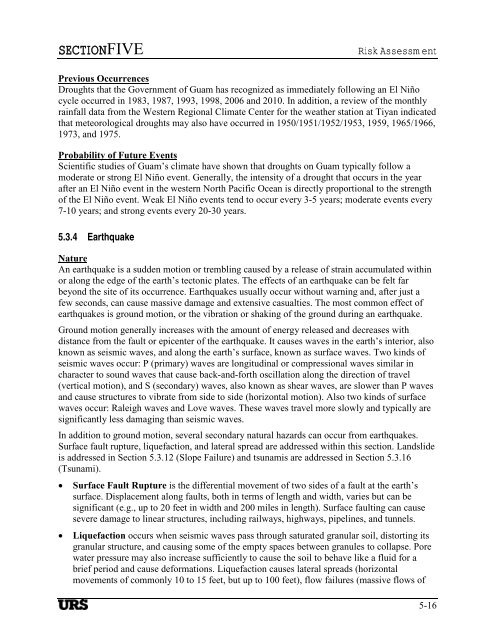Guam Hazard Mitigation Plan - Western States Seismic Policy Council
Guam Hazard Mitigation Plan - Western States Seismic Policy Council
Guam Hazard Mitigation Plan - Western States Seismic Policy Council
Create successful ePaper yourself
Turn your PDF publications into a flip-book with our unique Google optimized e-Paper software.
SECTIONFIVERisk AssessmentPrevious OccurrencesDroughts that the Government of <strong>Guam</strong> has recognized as immediately following an El Niñocycle occurred in 1983, 1987, 1993, 1998, 2006 and 2010. In addition, a review of the monthlyrainfall data from the <strong>Western</strong> Regional Climate Center for the weather station at Tiyan indicatedthat meteorological droughts may also have occurred in 1950/1951/1952/1953, 1959, 1965/1966,1973, and 1975.Probability of Future EventsScientific studies of <strong>Guam</strong>’s climate have shown that droughts on <strong>Guam</strong> typically follow amoderate or strong El Niño event. Generally, the intensity of a drought that occurs in the yearafter an El Niño event in the western North Pacific Ocean is directly proportional to the strengthof the El Niño event. Weak El Niño events tend to occur every 3-5 years; moderate events every7-10 years; and strong events every 20-30 years.5.3.4 EarthquakeNatureAn earthquake is a sudden motion or trembling caused by a release of strain accumulated withinor along the edge of the earth’s tectonic plates. The effects of an earthquake can be felt farbeyond the site of its occurrence. Earthquakes usually occur without warning and, after just afew seconds, can cause massive damage and extensive casualties. The most common effect ofearthquakes is ground motion, or the vibration or shaking of the ground during an earthquake.Ground motion generally increases with the amount of energy released and decreases withdistance from the fault or epicenter of the earthquake. It causes waves in the earth’s interior, alsoknown as seismic waves, and along the earth’s surface, known as surface waves. Two kinds ofseismic waves occur: P (primary) waves are longitudinal or compressional waves similar incharacter to sound waves that cause back-and-forth oscillation along the direction of travel(vertical motion), and S (secondary) waves, also known as shear waves, are slower than P wavesand cause structures to vibrate from side to side (horizontal motion). Also two kinds of surfacewaves occur: Raleigh waves and Love waves. These waves travel more slowly and typically aresignificantly less damaging than seismic waves.In addition to ground motion, several secondary natural hazards can occur from earthquakes.Surface fault rupture, liquefaction, and lateral spread are addressed within this section. Landslideis addressed in Section 5.3.12 (Slope Failure) and tsunamis are addressed in Section 5.3.16(Tsunami).• Surface Fault Rupture is the differential movement of two sides of a fault at the earth’ssurface. Displacement along faults, both in terms of length and width, varies but can besignificant (e.g., up to 20 feet in width and 200 miles in length). Surface faulting can causesevere damage to linear structures, including railways, highways, pipelines, and tunnels.• Liquefaction occurs when seismic waves pass through saturated granular soil, distorting itsgranular structure, and causing some of the empty spaces between granules to collapse. Porewater pressure may also increase sufficiently to cause the soil to behave like a fluid for abrief period and cause deformations. Liquefaction causes lateral spreads (horizontalmovements of commonly 10 to 15 feet, but up to 100 feet), flow failures (massive flows of5-16




